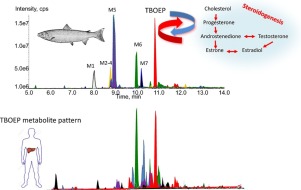Aquatic Toxicology ( IF 4.5 ) Pub Date : 2018-01-31 , DOI: 10.1016/j.aquatox.2018.01.014 Augustine Arukwe , Camilla Catarci Carteny , Trine Eggen , Monika Möder

|
Given the compound differences between tris(2-butoxyethyl)- and tris(2-cloroethyl) phosphate (TBOEP and TCEP, respectively), we hypothesized that exposure of juvenile salmon to TBOEP and TCEP will produce compound-specific differences in uptake and bioaccumulation patterns, resulting in potential formation of OH-metabolites. Juvenile salmon were exposed to waterborne TCEP or TBOEP (0.04, 0.2 and 1 mg/L) for 7 days. The muscle accumulation was measured and bioconcentration factor (BCF) was calculated, showing that TCEP was less accumulative and resistant to metabolism in salmon than TBOEP. Metabolite formations were only detected in TBOEP-exposed fish, showing seven phase I biotransformation metabolites with hydroxylation, ether cleavage or combination of both reactions as important metabolic pathways. In vitro incubation of trout S9 liver fraction with TBOEP was performed showing that the generated metabolite patterns were similar to those found in muscle tissue exposed in vivo. However, another OH-TBOEP isomer and an unidentified metabolite not present in in vivo exposure were observed with the trout S9 incubation. Overall, some of the observed metabolic products were similar to those in a previous in vitro report using human liver microsomes and some metabolites were identified for the first time in the present study. Toxicological analysis indicated that TBOEP produced less effect, although it was taken up faster and accumulated more in fish muscle than TCEP. TCEP produced more severe toxicological responses in multiple fish organs. However, liver biotransformation responses did not parallel the metabolite formation observed in TBOEP-exposed fish.
中文翻译:

暴露于有机磷酸酯(磷酸三(2-丁氧基乙基)-和三(2-氯乙基)酯)的鲑鱼的吸收模式,代谢物形成和毒理学响应的新方面
考虑到磷酸三(2-丁氧基乙基)-和三(2-氯乙基)之间的化合物差异(分别为TBOEP和TCEP),我们假设将少年鲑鱼暴露于TBOEP和TCEP会在吸收和生物蓄积模式方面产生化合物特异性差异,导致潜在的OH代谢物形成。将未成年鲑鱼暴露于水性TCEP或TBOEP(0.04、0.2和1 mg / L)7天。测量了肌肉的积累并计算了生物浓缩因子(BCF),表明TCEP与TBOEP相比,在鲑鱼中的蓄积性较低,并且对新陈代谢的抵抗力较弱。仅在暴露于TBOEP的鱼中检测到代谢物形成,显示出具有羟基化,醚裂解或两种反应结合作为重要代谢途径的7种I期生物转化代谢物。体外用TBOEP进行鳟鱼S9肝组分的孵育表明,所产生的代谢产物类似于体内暴露的肌肉组织中的代谢产物。然而,在鳟鱼S9孵育中观察到了另一种OH-TBOEP异构体和体内暴露中不存在的未知代谢物。总体而言,观察到的某些代谢产物与之前的体外实验相似本研究首次使用人肝微粒体报告了一些代谢物。毒理学分析表明,尽管TBOEP吸收速度更快,并且在鱼肌肉中的蓄积量比TCEP少,但产生的作用较小。TCEP在多个鱼类器官中产生了更严重的毒理反应。但是,肝脏生物转化反应与暴露于TBOEP的鱼中观察到的代谢物形成不平行。

























 京公网安备 11010802027423号
京公网安备 11010802027423号